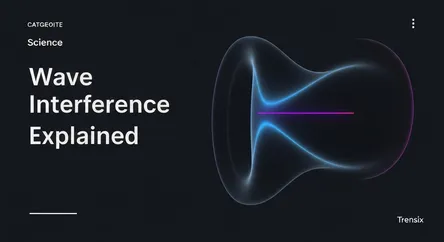Science
Wave Interference Explained

Discover how wave interference, the meeting of two or more waves, creates everything from noise-canceling tech to the colors on a soap bubble.
What is it?
Interference is a physical phenomenon that occurs when two or more waves meet and combine. This superposition can result in a new wave that is either stronger, weaker, or the same amplitude as the original waves. There are two main types: constructive interference, where the wave crests align to create a more powerful wave, and destructive interference, where the crest of one wave meets the trough of another, canceling each other out to reduce or eliminate the wave. This principle applies to all kinds of waves, including light, sound, and water.
Why is it trending?
Interference is a cornerstone principle in physics that drives innovation in modern technology. It is fundamental to quantum mechanics, famously demonstrated in the double-slit experiment which reveals the wave-particle duality of matter. Furthermore, advanced applications like the Laser Interferometer Gravitational-Wave Observatory (LIGO) use light interference to detect gravitational waves from cosmic events, opening new windows into the universe. In telecommunications, techniques like beamforming in 5G networks manipulate radio wave interference to enhance signal strength and speed, making it a critical concept in our increasingly connected world.
How does it affect people?
The principle of interference has a significant impact on everyday life and technology. Noise-canceling headphones are a prime example, using destructive interference to eliminate ambient sounds. In medicine, ultrasound imaging relies on sound wave interference to create detailed images of internal body organs for non-invasive diagnostics. The iridescent colors seen on soap bubbles or peacock feathers are created by the interference of light waves. It's also used in anti-reflective coatings on eyeglasses and in the design of concert halls to ensure optimal sound quality.